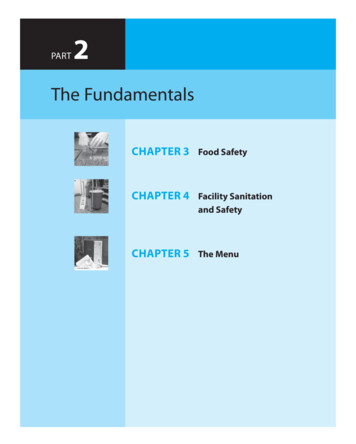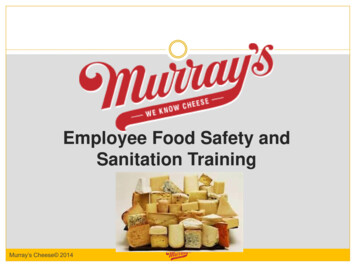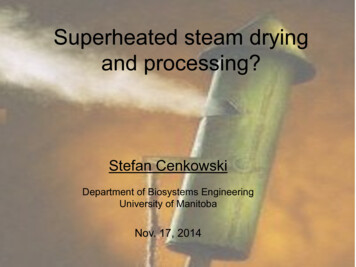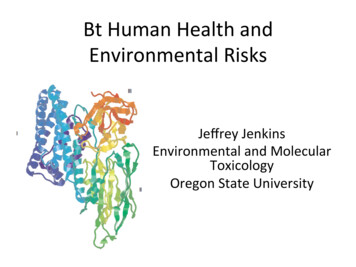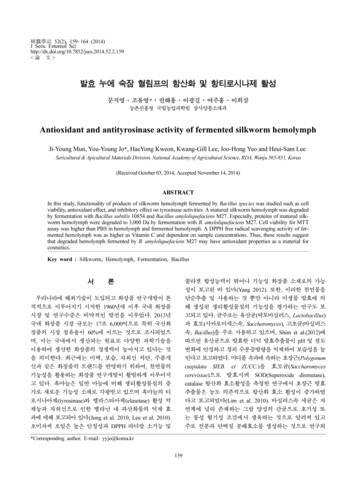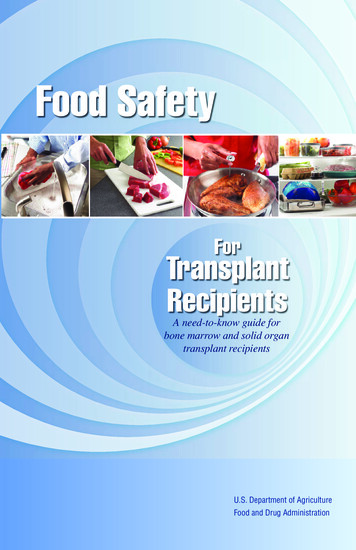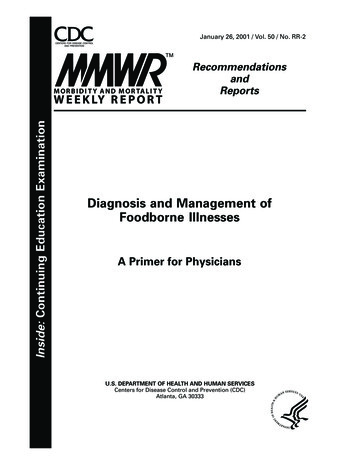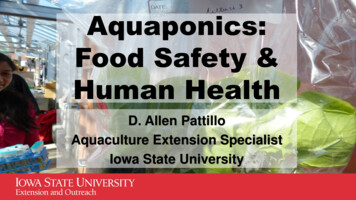
Transcription
FSHN15-06Preventing Foodborne Illness: Bacillus cereus1Keith R. Schneider, Renée Goodrich Schneider, Rachael Silverberg, Ploy Kurdmongkoltham,and Bruna Bertoldi2This is one in a series of facts sheets discussing commonfoodborne pathogens of interest to food handlers, processors, and retailers.What is Bacillus cereus?Bacillus cereus is a Gram positive, facultative anaerobicbacterium characterized by large rod-shaped cells andan ability to form heat-resistant endospores. Since thisbacterium is commonly widespread in the environmentand is often found in soil, it is naturally present in a widerange of food products of both plant and animal origin.B. cereus grows best in a temperature range of 39ºF (4ºC) to118ºF (48ºC). Optimal growth occurs within the narrowertemperature range of 82ºF (28ºC) to 95ºF (35ºC) and a pHrange of 4.9 to 9.3 (FDA 2012b).While there are numerous known species in the genusBacillus, only two, B. anthracis and B. cereus, are associatedwith human diseases. Bacillus anthracis, though pathogenic,is rarely linked to foodborne illness. However, Bacillus cereus is the known source of two distinct types of foodborneillness. Both illnesses are associated with the ingestion ofa distinct toxin produced by the bacteria. The first form isemetic, which is characterized by nausea, vomiting, andabdominal cramps. The emetic form has a short onset timeof about 1 to 6 hours after consumption of contaminatedfoods and is caused by the ingestion of a pre-formed toxinthat contaminates food prior to eating. The temperaturefor emetic toxin (cereulide) production ranges from 77ºF(25ºC) to 86ºF (30ºF) (FDA 2013a). The second form causesdiarrhea and has a longer onset time of about 6 to 15 hoursand can last approximately 24 hours. This form of the illness is caused by enterotoxins (toxins that specifically affectthe intestinal mucosa) produced by B. cereus inside the hostafter ingestion (FSANZ 2013; Naranjo et al. 2011).Figure 1. A colony of Bacillus cereus.Credits: CDC/ Amanda Moore, MT; Todd Parker, PhD; Audra MarshTransmission of Foodborne IllnessDue to its ubiquity in the environment, B. cereus is easilyspread to many types of fresh and processed food products.It is found in the environment and on many foods,including meat, cereal dishes, vegetables, milk, products,1. This document is FSHN15-06, one of a series of the Food Science and Human Nutrition Department, UF/IFAS Extension. Original publication dateAugust 2015. Revised April 2017. Visit the EDIS website at http://edis.ifas.ufl.edu.2. Keith R. Schneider, professor; Renée Goodrich Schneider, professor; and Rachael Silverberg, lab technician; Ploy Kurdmongkoltham, lab technician;Bruna Bertoldi, lab technician; Department of Food Science and Human Nutrition; UF/IFAS Extension, Gainesville, FL 32611.The Institute of Food and Agricultural Sciences (IFAS) is an Equal Opportunity Institution authorized to provide research, educational information and other services only toindividuals and institutions that function with non-discrimination with respect to race, creed, color, religion, age, disability, sex, sexual orientation, marital status, nationalorigin, political opinions or affiliations. For more information on obtaining other UF/IFAS Extension publications, contact your county’s UF/IFAS Extension office.U.S. Department of Agriculture, UF/IFAS Extension Service, University of Florida, IFAS, Florida A & M University Cooperative Extension Program, and Boards of CountyCommissioners Cooperating. Nick T. Place, dean for UF/IFAS Extension.
puddings, and soups, but it does not usually pose a healthrisk. Illness usually occurs when food is improperly cookedand stored in the danger zone (41ºF to 135ºF) (FDA 2013a)for an extended period of time (Marriot and Gravani 2006).Transmission of the diarrheal form of the illness is causedby ingestion of viable cells or spores. These cells grow in thebody and secrete toxins (whereas the emetic form producesa toxin on the food and is ingested preformed) (Bottone2010). The diarrheal form typically requires a concentrationof 100,000 cells/g or greater to cause illness (FDA 2012).In most instances, illnesses associated with B. cereus arealmost exclusively the result of improper food handling,storage, and cooling that allow for growth of B. cereus and/or production of emetic toxins.Cooking contaminated food at recommended temperaturesdestroys the vegetative cells of B. cereus. Heat-resistantendospores of this bacteria are more likely to survivecooking and start growing again (germinate) when the foodis cooled gradually over an extended period of time. Theemetic toxin (cereulide) is heat stable up to 121ºC (250ºF)(Rajkovic 2014). If stored at improper temperatures forseveral hours before serving ( 41ºF (5ºC) for cold food; 135ºF (57ºC) for hot food), hazardous concentrations ofbacterial cells or toxins could develop prior to consumption(HPSC 2012). The temperature range between 57ºC (135ºF)and 5ºC (41ºF) is known as the danger zone for foodstorage and thus should be avoided (FDA 2013a).Additional sources of foodborne illness outbreaks could beimproper hygiene during food canning and inadequate reheating of food in congregate settings, such as restaurantsand schools (HPSC 2012).What foods have been commonlyassociated with Bacillus cereus?A broad range of foods have been implicated as vehiclesof B. cereus. These include boiled or fried rice, cookedvegetables and meats, pasta, vanilla sauce, custards, casseroles, pastries, salads, soups, ice cream, and herbs andspices (FDA 2012). The emetic form of illness (vomiting)is most frequently associated with improperly refrigeratedstarch dishes, such as fried rice; whereas, the diarrhealform of illness is associated with foods containing meat andvegetables (Todar 2012).There are many examples of outbreaks caused by thisorganism. In 2014 in China, 139 people reported nausea,vomiting, and diarrhea after consuming fermented blackbeans. Three strains of B. cereus were isolated from thePreventing Foodborne Illness: Bacillus cereusoutbreak, including two strains known to produce theemetic toxin and one known to produce the diarrhealenterotoxin (Zhou et al. 2014). Another severe outbreakoccurred in 2003, in Leuven, Belgium, where five childrenin one family became ill after consuming pasta salad thatcontained the emetic toxin. The pasta was stored in arefrigerator set at 57.2 F (14 C), which is much higher thanthe proper storage temperature of 41 F (5 C). The youngestchild, a 7 year-old girl, died in the hospital only 13 hoursafter consuming the pasta (Dierick et al. 2005). The Centersfor Disease Control and Prevention (CDC) estimates thatB. cereus was responsible for 63,400 cases of foodborneillness and 20 hospitalizations in the United States each yearbetween 2000 and 2008 (Scallan et al. 2011; CDC 2012a). Inaddition, a 2012 CDC surveillance annual report reportedtwo outbreaks and 24 illnesses involving B. cereus in theUnited States (CDC 2012b). However, many cases are neverreported or diagnosed in a clinical setting because theassociated symptoms are usually mild and/or short-lastingin nature. Table 1 outlines recent B. cereus foodborneoutbreaks.Preventing Contamination by B.cereusBecause B. cereus endospores are extremely heat resistant,they are likely to survive cooking at temperatures thatwould otherwise destroy foodborne pathogen cells. Heatresistance increases with increasing salinity (presence ofsalt) and decreases with increasing acidity. Bacillus cereusspores can germinate when exposed to heat or improperhandling; therefore, the 2013 Food Code recommends thathot foods be maintained at a temperature of 135ºF (57ºC)or above and cold foods be maintained at a temperature of41ºF (5ºC) or below (FDA 2013a).According to the National Institutes of Health (NIH), theNational Institute of Allergy and Infectious Diseases (NIAID), the National Food Processors Association (NFPA),and the FDA Food Code 2013, the suggestions below aregood methods and practices that destroy B. cereus: Steaming under pressure, roasting, frying, and grillingfoods will destroy the vegetative cells and spores iftemperatures within foods are 145ºF (63ºC). Since foods containing the emetic toxin need to be heatedto 249ºF (121ºC) for more than 80 minutes, reheatingfoods until they are steaming is not enough to inactivatethe emetic toxin and efforts should be devoted to prevention (Rajkovic 2014).2
Heating (i.e., cooking) to 145ºF (63ºC) and reheatingto 165ºF (74ºC) for 15 seconds will destroy the vegetative(actively growing) cells. Once cooked, the rapid coolingof the product will prevent any spores present fromgerminating. However, note that foods cannot be madesafe to eat if toxins have already been formed.the improper holding of cooked foods. Refer to sections3-401.11 to 3-401.14 and 3-403.11 of the 2013 Food Code. Keep hot foods above 135ºF (57ºC) and cold foods below41ºF (5ºC) to prevent the formation of spores. Fruits and vegetables cooked for hot holding should becooked to an internal temperature of 135ºF (57ºC). Refrigerate leftovers properly by cooling rapidly to 41ºF(5ºC) or below. Make sure leftover containers are notstacked close together; this will allow for adequate airflowaround the food and ensure rapid cooling. Hold all hot food at a temperature of 135ºF (57ºC) orhigher.Good Practices for Food ProductReceiving, Handling, Processing,and StorageThe FDA defines current Good Manufacturing Practices(GMPs) in the Code of Federal Regulations, Title 21, Part117 (FDA 2017). These GMPs outline minimal sanitationrequirements in FDA-inspected food handling and processing facilities. It is recommended that more specific andstringent standard operating procedures (SOPs) be developed for individual facilities. In addition, the sanitationrecommendations for food service and retail food facilitiesoutlined in the FDA 2009 Food Code were adopted as lawby sixteen states, including Florida, as of August 2013 (FDA2016). The FDA updated the 2009 Food Code with therelease of the 2013 Food Code. Since the adoption of thenew versions of the Food Code varies by state, it is important that each facility checks with the appropriate state orlocal regulatory authority to make sure they are using theguidelines required by their jurisdiction. The Florida statuescan be found at http://www.leg.state.fl.us/statutes, Title 33:Chapter 509.In addition to setting and adhering to strict sanitationrequirements in the facility, a retail establishment shouldalso develop SOPs for the receiving and storing of foodproducts and ingredients. If food is being processed, appropriate controls and requirements should be establishedand strictly adhered to. The FDA 2013 Food Code outlinesappropriate processing and cooking requirements for foodservice.ProcessingOne of the easiest ways to prevent foodborne illness associated with B. cereus is by ensuring that foods are cookedthoroughly and cooled rapidly. One of the leading causesof foodborne infections and intoxications by B. cereus isPreventing Foodborne Illness: Bacillus cereus Raw animal meats should be cooked to an internaltemperature of 145ºF (63ºC) or above and be held for aminimum of 15 seconds at that temperature. Chill cooked foods promptly. Cooked food should notbe left out at room temperature for more than 2 hours,especially meat. Reheating previously cooked food so that all parts ofthe food reach an internal temperature of at least 165ºF(74ºC) for 15 seconds will kill most harmful bacteria,but may not be adequate to inactivate existing toxins(Rajkovic 2014). (Note: Contaminated food should neverknowingly be served, even if reheated properly. If a foodis thought to be contaminated, it should be disposed of.When in doubt, throw it out!)StorageOnce a product has been received or processed, it shouldbe properly displayed or stored. There are some generalguidelines governing these practices as well. Refer tosections 3-501.13 and 3-501.14 of the 2013 Food Code. Frozen food should remain frozen until used. If frozen food is displayed in a refrigerated case andallowed to thaw, the food should remain at 41ºF (5ºC) orbelow. Frozen food should be thawed at a temperature of 41ºF(5ºC) or below or under running water at a temperatureof 70ºF (21ºC) or below. The product can be thawed as part of the cooking process. Food should be cooled from 135ºF (57ºC) to 70ºF (21ºC)within a period of two hours. Overall, the cooling process from 135ºF (57ºC) to 41ºF(5ºC) should take no more than 6 hours. Cooked product should be maintained above 135ºF(57ºC) while displayed and stored at or under 41ºF (5ºC)for no more than 7 days. Properly label all stored food products. Always remember, when in doubt, throw it out.For more specific recommendations consult the 2013Food Code: http://www.fda.gov/downloads/Food/3
CM374510.pdfReferencesBritish Columbia Centre for Disease Control (BCCDC).2002. “Foodborne Illness Outbreaks: Bacillus cereus.”Milk Safety Notes. Accessed March 6, 2017. 0-B03235FE8AAD409F/0/Outbreak Bacillus Milk.pdfBottone EJ. 2010. “Bacillus cereus, a Volatile Human Pathogen.” Clinical Microbiology Reviews. 23 (2): 382–398.Centers for Disease Control and Prevention (CDC). 2012a.Pathogens Causing US Foodborne Illnesses, Hospitalizations,and Deaths, 2000–2008. Accessed March 6, 2017. omplete-list-01-12.pdfCenters for Disease Control and Prevention (CDC). 2012b.Surveillance for Foodborne Disease Outbreaks United States,2012: Annual Report. Accessed March 6, 2017. ase-outbreaksannual-report-2012-508c.pdfCenters for Disease Control and Prevention (CDC). 1994.“Epidemiologic Notes and Reports: Bacillus cereus FoodPoisoning Associated with Fried Rice at Two Child DayCare Centers—Virginia, 1993.” Morbidity and MortalityWeekly Report. 43 (10):177–178. Accessed March 13, ers for Disease Control and Prevention (CDC). 1986.“Bacillus cereus – Maine.” Morbidity and Mortality WeeklyReport. 35 (25): 408–410. Accessed March 13, 2017. .htmDierick, K, E Van Coillie, I Swiecicka, G Meyfroidt, HDevlieger, A Meulemans, G Hoedemaekers, L Fourie, MHeyndrickx, and J Mahillon. 2005. “Fatal Family Outbreakof Bacillus cereus-Associated Food Poisoning.” Journal ofClinical Microbiology. 43 (8): 4277–4279.Delbrassinne, L, N Botteldoorn, M Andjelkovic, K Dierick,and S Denayer. 2015. “An Emetic Bacillus cereus Outbreakin a Kindergarten: Detection and Quantification of CriticalLevels of Cereulide Toxin.” Foodborne Pathogens andDisease. 12 (1): 84–87.Preventing Foodborne Illness: Bacillus cereusFlorida Department of Public Health (DOH). 2011.“Outbreak at Okeechobee Correctional Institute.” Food forThought. Accessed April 19, 2017 http://www.outbreakdatabase.com/reports/Florida Dept. of health Publication, Food for Thought, Issue 1, February 2011, Seepage 2 .pdfFood and Drug Administration (FDA). 2017. Code ofFederal Regulations Title 21-Part 117—Current GoodManufacturing Practice, Hazard Analysis, and Risk-BasedPreventive Controls for Human Food. Accessed January 30,2017: http://www.ecfr.gov/cgi-bin/text-idx?SID 242e99958fe0d430b7ab4c404b393bba&mc true&node pt21.2.117&rgn div5Food and Drug Administration (FDA). 2016. Real Progressin Food Code Adoption. Accessed April 13, 2017. d and Drug Administration (FDA). 2013a. Food Code2013. US Public Health Service. Accessed March 7, fFood and Drug Administration (FDA). 2012. Bacilluscereus and Other Bacillus spp. Bad Bug Book: FoodbornePathogenic Microorganisms and Natural Toxins Handbook.92–95. Accessed March 6, 2017. Contaminants/UCM297627.pdfFood Standards Australia New Zealand (FSANZ). 2013.Bacillus cereus. Accessed March 6, 2017. ents/Bacillus%20cereus.pdfHealth Protection Surveillance Center (HPSC). 2012.“Bacillus cereus Food-borne Illness.” Infectious IntestinalDisease: Public Health and Clinical Guidance. AccessedMarch 6, 2017. isorIID/Guidance/File,13492,en.pdfMarriot, NG and RB Gravani. 2006. The Relationship ofMicroorganisms Sanitation. Principles of Food Sanitation(5th ed.) Springer Science Business Media, Inc.Naranjo, M, S Denayer, N Botteldoorn, L Delbrassinne,J Veys, J Waegenaere, N Sirtaine, R Driesen, K Sipido, JMahillon, and K Dierick. 2011. “Sudden Death of a YoungAdult Associated with Bacillus cereus Food Poisoning.”Journal of Clinical Microbiology. 49 (12): 4379–4381.4
Ontario Agency for Health Protection and Promotion(OAHPP). 2015. “Case Study: Evidence of FoodborneOutbreaks Associated with Pizza.” Public Health OntarioPartners for Health. Accessed March 9, 2017. ase Study Pizza 2015.pdfRajkovic, A. 2014. “Microbial toxins and low level offoodborne exposure.” Trends in Food Science & Technology.38 (2): 149–157.Scallan, E, RB Hoekstra, FJ Angulo, RV Tauxe, MA Widdowson, SL Roy, JL Jones, PM Griffin. 2011. “FoodborneIlness Acquired in the United States- Major Pathogens.”Emerging Infectious Diseases. 17(1): 7–15. Accessed March6, 2017. 61/#SD1Todar, K. 2012. “Bacillus cereus Food Poisoning.” In Todar’sOnline Textbook of Bacteriology. Accessed March 27, mlZhou, G, K Bester, B Liao, Z Yang, R Jiang, and NB Hendriksen. 2014. “Characterization of Three Bacillus cereusStrains Involved in a Major Outbreak of Food PoisoningAfter Consumption of Fermented Black Beans (Douchi) inYunan, China.” Foodborne Pathogens and Disease. 11 (10):769–774.Preventing Foodborne Illness: Bacillus cereus5
for Disease Control and Prevention (CDC) estimates that B. cereus was responsible for 63,400 cases of foodborne illness and 20 hospitalizations in the United States each year between 2000 and 2008 (Scallan et al. 2011; CDC 2012a). In addition, a 2012 CDC surveillance annual report reported two outbreaks and 24 illnesses involving B. cereus in the
